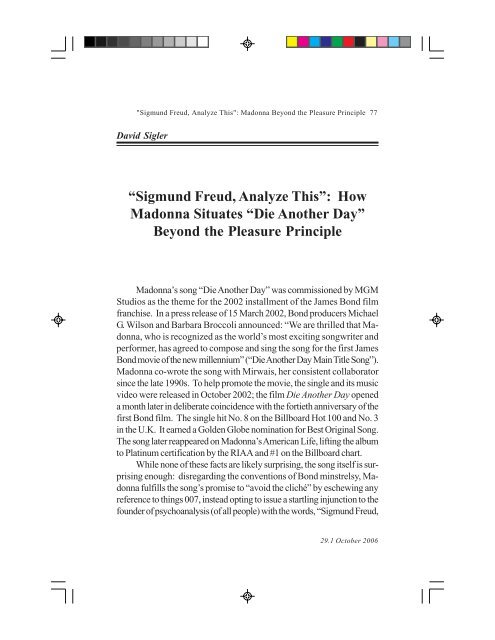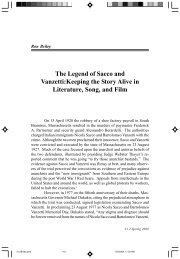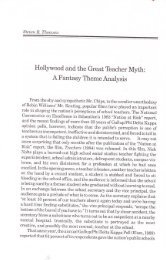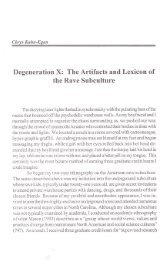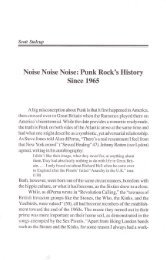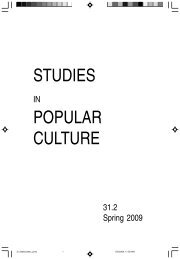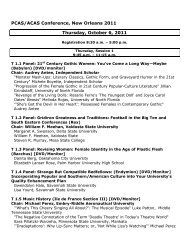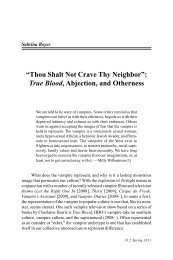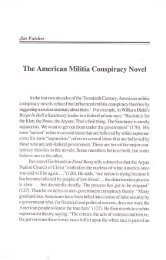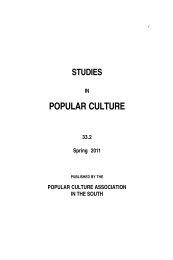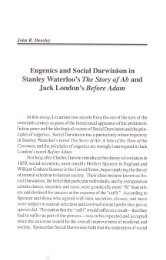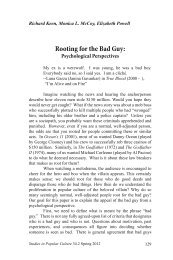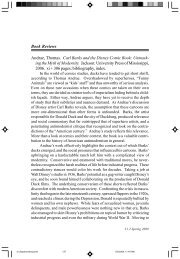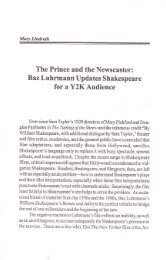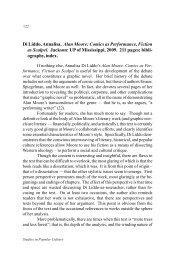'Sigmund Freud, Analyze This': How Madonna Situates - Popular ...
'Sigmund Freud, Analyze This': How Madonna Situates - Popular ...
'Sigmund Freud, Analyze This': How Madonna Situates - Popular ...
Create successful ePaper yourself
Turn your PDF publications into a flip-book with our unique Google optimized e-Paper software.
"Sigmund <strong>Freud</strong>, <strong>Analyze</strong> This": <strong>Madonna</strong> Beyond the Pleasure Principle 77<br />
David Sigler<br />
“Sigmund <strong>Freud</strong>, <strong>Analyze</strong> This”: <strong>How</strong><br />
<strong>Madonna</strong> <strong>Situates</strong> “Die Another Day”<br />
Beyond the Pleasure Principle<br />
<strong>Madonna</strong>’s song “Die Another Day” was commissioned by MGM<br />
Studios as the theme for the 2002 installment of the James Bond film<br />
franchise. In a press release of 15 March 2002, Bond producers Michael<br />
G. Wilson and Barbara Broccoli announced: “We are thrilled that <strong>Madonna</strong>,<br />
who is recognized as the world’s most exciting songwriter and<br />
performer, has agreed to compose and sing the song for the first James<br />
Bond movie of the new millennium” (“Die Another Day Main Title Song”).<br />
<strong>Madonna</strong> co-wrote the song with Mirwais, her consistent collaborator<br />
since the late 1990s. To help promote the movie, the single and its music<br />
video were released in October 2002; the film Die Another Day opened<br />
a month later in deliberate coincidence with the fortieth anniversary of the<br />
first Bond film. The single hit No. 8 on the Billboard Hot 100 and No. 3<br />
in the U.K. It earned a Golden Globe nomination for Best Original Song.<br />
The song later reappeared on <strong>Madonna</strong>’s American Life, lifting the album<br />
to Platinum certification by the RIAA and #1 on the Billboard chart.<br />
While none of these facts are likely surprising, the song itself is surprising<br />
enough: disregarding the conventions of Bond minstrelsy, <strong>Madonna</strong><br />
fulfills the song’s promise to “avoid the cliché” by eschewing any<br />
reference to things 007, instead opting to issue a startling injunction to the<br />
founder of psychoanalysis (of all people) with the words, “Sigmund <strong>Freud</strong>,<br />
29.1 October 2006
78 David Sigler<br />
analyze this.” 1 This is a most curious moment, and one that warrants our<br />
further investigation: why, when called upon to sell another dose of James<br />
Bond to an ever-willing public, would <strong>Madonna</strong> ignore the screenplay<br />
and instead address <strong>Freud</strong>?<br />
This essay takes <strong>Madonna</strong> up on her invitation to <strong>Freud</strong>, reading<br />
“Die Another Day” alongside Beyond the Pleasure Principle, the revolutionary<br />
and dense text of 1920 wherein <strong>Freud</strong> introduces the concept of<br />
the death instinct. It seeks to understand why <strong>Madonna</strong> would call for<br />
<strong>Freud</strong> in this song, and indeed why the <strong>Freud</strong> of Beyond the Pleasure<br />
Principle specifically. <strong>Madonna</strong>’s demand and invitation to <strong>Freud</strong> marks<br />
the end of the song’s introduction and gets us dancing in earnest; the rest<br />
of the song is filled with resolutions consistent with <strong>Freud</strong>’s concept of the<br />
death instinct, such as “I’m gonna delay my pleasure,” “I’m gonna destroy<br />
my ego,” and “I’m gonna close my body now.” Does <strong>Madonna</strong> offer her<br />
song as a challenge to psychoanalysis, as we might suspect when she<br />
laughs somewhat diabolically and whispers “I need to lay down” into the<br />
microphone? Or is she instead offering her song to the listener as analyzable<br />
dream-imagery, as suggested by her opening line, “I’m gonna wake up,<br />
yes and no”? This paper addresses these problems, and then concludes<br />
with the claim that <strong>Madonna</strong>, either cannily or unconsciously, makes good<br />
on her contract to MGM in referring us to Beyond the Pleasure Principle,<br />
insofar as Beyond is precisely the text that accounts for the pleasures<br />
of watching a Bond film. <strong>Madonna</strong>’s appeal to <strong>Freud</strong>, be it invitation<br />
or dare or injunction, subtly constitutes the best of possible advertisements<br />
for the film. Thus <strong>Madonna</strong>’s “analyze this” exploits a dare until it<br />
functions as truth also.<br />
We may wonder: has <strong>Madonna</strong> actually read Beyond the Pleasure<br />
Principle? This seems possible, given the consistency with which the<br />
song “Die Another Day” addresses issues raised by this one text. It is<br />
beyond doubt that <strong>Madonna</strong> has something specifically <strong>Freud</strong>ian in mind,<br />
as she demands a <strong>Freud</strong>ian reading of her song as explicitly as possible.<br />
But the depth to which <strong>Madonna</strong> has studied <strong>Freud</strong>, and the rigor of that<br />
study, is difficult to estimate or even ascertain. That issue, though, is im-<br />
Studies in <strong>Popular</strong> Culture
"Sigmund <strong>Freud</strong>, <strong>Analyze</strong> This": <strong>Madonna</strong> Beyond the Pleasure Principle 79<br />
material for my purposes here: in this paper, I am more interested in the<br />
effect created by <strong>Madonna</strong>’s conversation with <strong>Freud</strong> than in its motivation.<br />
That is, I am interested in contemplating what <strong>Madonna</strong>’s gesture<br />
might itself mean, not really what she means by it.<br />
Beyond the Pleasure Principle is <strong>Freud</strong>’s most speculative work<br />
and perhaps his most interesting. The text is famous not only for its theoretical<br />
daring but also because it ushers in the final topological phase of<br />
<strong>Freud</strong>’s career and introduces the ever-controversial concepts of repetition<br />
compulsion and the death instinct. The body of scholarly work on<br />
Beyond is staggering, having warranted book-length commentaries by<br />
thinkers including Derrida, Lacan, and Laplanche. 2 Beyond is a text about<br />
repetition, desire, the binding and unbinding of the libido, the death instinct’s<br />
struggle with the erotic instinct, about trauma, dreams, and mastery. This<br />
is also the text where <strong>Freud</strong> discusses his young grandson’s game of “fort!”<br />
and “da!”, one of the most immediately recognizable moments in <strong>Freud</strong><br />
even to non-specialists (Standard Edition XVIII: 14-17). It is a perplexing<br />
text, even to the extent that <strong>Freud</strong> frequently undermines his own arguments<br />
whenever objections spring to his mind. He even goes so far at one<br />
point as to disclaim its revolutionary findings, insisting that he is not himself<br />
persuaded by his new hypotheses, nor does he expect the reader to be<br />
persuaded (SE XVIII: 59). And yet the implications of his speculations<br />
here compel <strong>Freud</strong> to revise central tenets of psychoanalytic theory, and<br />
he makes these revisions right here in this text: here for the first time, for<br />
instance, he acknowledges that some dreams are not fulfillments of wishes,<br />
and that there might be such a thing as primary masochism (SE XVIII: 32,<br />
55). <strong>Freud</strong> has made a major discovery here, and only by a line of reasoning<br />
and self-doubt that would do even Descartes proud. He has<br />
dared to inquire into the existence of another process, one independent of<br />
the pleasure and reality principles, preceding them and more fundamental.<br />
The discovery of the death instinct marks a genuine revolution in psychoanalysis:<br />
no matter the disarming degree of uncertainty with which <strong>Freud</strong><br />
proposes the idea, he never backs away from the concept of the death<br />
instinct in any of his later writings. Hence Beyond the Pleasure Principle<br />
29.1 October 2006
80 David Sigler<br />
is often read as the first text of the last phase of <strong>Freud</strong>’s career: texts as<br />
central as The Ego and The Id, Civilization and its Discontents, and Group<br />
Psychology follow from the premises introduced here. Partly because of<br />
its stock of shocking new concepts and its strange habit of undermining its<br />
own diabolical arguments as it presents them, Beyond is commonly numbered<br />
among <strong>Freud</strong>’s most difficult texts.<br />
The speculations of Beyond the Pleasure Principle populate<br />
<strong>Madonna</strong>’s song to a remarkable extent, and these carry with them significant<br />
effects—even forcing us to reconsider what it might mean to “die<br />
another day.” Die Another Day, like all Bond films, is an action picture<br />
about espionage kept as courteous as possible in the face of international<br />
skullduggery. Unlike many Bond films, though, the British intelligence<br />
community has here been undermined from within: this time Bond has<br />
been betrayed by a mole, suspended and disavowed by his employers,<br />
and now he needs to act (mostly) alone to solve the horrifying mystery of<br />
Colonel Tan-Sun Moon’s weapons-for-diamonds scheme. 3 At its most<br />
literal level, the title of the film refers to the physical transformation and<br />
persistence of Colonel Moon, who has somehow survived his first brush<br />
with Bond only to reappear, genetically altered, as the evil megalomaniac<br />
Gustav Graves. 4 Bond jests upon encountering his transformed nemesis<br />
that Graves is finally ready to “die another day.” But viewers of the film<br />
will sense as well that its title is also supposed to refer to James Bond’s<br />
own fortitude and indestructibility: the title is a testament both to James<br />
Bond’s wily charm and the character’s enduring public appeal. We sense<br />
this because Die Another Day, even more than other Bond films, demands<br />
to be read as either an homage to the venerable film franchise or a<br />
postmodern exploitation of its signal motifs. The imagery and dialogue of<br />
the film are filled with winking references to nearly every preceding film in<br />
the series, suggesting that Bond himself—both in the plot of the film and in<br />
twenty-first century culture—will not die until another day.<br />
<strong>Madonna</strong>’s song attempts none of these self-congratulatory gestures,<br />
and instead infuses the titular phrase with a whole range of new and specifically<br />
<strong>Freud</strong>ian meanings: its “Die Another Day” is not a matter of en-<br />
Studies in <strong>Popular</strong> Culture
"Sigmund <strong>Freud</strong>, <strong>Analyze</strong> This": <strong>Madonna</strong> Beyond the Pleasure Principle 81<br />
durance but rather seems to refer to negotiation and deferral. <strong>Madonna</strong>’s<br />
lyrics frame the song’s title and chorus in relation to an internally regulated<br />
and flexible death instinct: “I think I’ll find another way . . . I guess I’ll die<br />
another day.” In uttering these lines, <strong>Madonna</strong> speaks not as the voice<br />
refusing death but as the organism committed to the singularity of its own<br />
death. She will die another day because, as she puts it, “it’s not my time to<br />
go.” Or, if one prefers <strong>Freud</strong>’s version, “the organism wishes to die only<br />
in its own fashion” (SE XVIII: 39). In <strong>Freud</strong>’s theoretical model, the<br />
pleasure and reality principles work to forestall the fundamental drive toward<br />
destruction: even though “the aim of all life is death,” the erotic and<br />
death instincts negotiate a compromise, one that <strong>Freud</strong> calls “a lengthening<br />
of the road to death” (SE XVIII: 38, 40, emphasis in original). In<br />
<strong>Freud</strong>’s terms, “one group of instincts rushes forward so as to reach the<br />
final aim of life as swiftly as possible, . . . the other group jerks back to<br />
make a fresh start and so prolong the journey” (SE XVIII: 41). According<br />
to <strong>Freud</strong>, death is always an internal process: each organism finds its<br />
preferred and proper way to die by deferring the impulse that would destroy<br />
the organism immediately.<br />
<strong>Freud</strong> calls this deferral “a short-circuit” (SE XVIII: 39), a metaphor<br />
that becomes grossly literalized at the end of the “Die Another Day”<br />
music video. The video, directed by the Swedish advertising team Traktor,<br />
redeploys several themes from the Die Another Day film, including imagery<br />
of fencing and torture. It features four separate locations, each featuring<br />
one or more <strong>Madonna</strong>s, and makes little attempt to connect them<br />
through any overarching narrative. In one scene we see <strong>Madonna</strong>, dressed<br />
in a tanktop and bedraggled by torture, thoroughly enjoying her sufferings<br />
as she lip-synchs the words to the song; she has been captured by menacing<br />
Asian men and is being prepared for death by electrocution. In another<br />
scene we find two fencers dueling on a red carpet in a seeming<br />
palace, the halls decked with suits of armor. In a third scene we see<br />
<strong>Madonna</strong>, alone, dancing while shackled and confined in a small, dank<br />
cell. In the fourth scene we find ourselves with <strong>Madonna</strong> amidst several<br />
display cases that seem to hold glass collector’s items. The video alter-<br />
29.1 October 2006
82 David Sigler<br />
nates freely and rapidly between these scenes, suggesting their narrative<br />
simultaneity, and interlaces them only incompletely toward the end of the<br />
video when the fencers smash through a window in their palace and find<br />
themselves in the fourth set, ready to destroy its collection as collateral<br />
damage to their fierce struggle.<br />
We can understand the music video as a series of dream-images,<br />
especially since <strong>Madonna</strong> opens the song with the line, “I’m gonna wake<br />
up, yes and no.” Her “yes and no” signals that we are squarely in the<br />
domain of the unconscious, where “yes and no” are indistinguishable (such<br />
is <strong>Freud</strong>’s position, at least, in his essay “Negation” [SE XIX: 235-39]).<br />
Within these dream-images, mirrors are smashed, fetishized collectables<br />
are dashed to bits, and <strong>Madonna</strong>s fight each other in a scene that recalls<br />
Poe’s “William Wilson” more than any Bond film. 5 By the end of the song<br />
<strong>Madonna</strong> still hasn’t awakened: in an unusual effect even for dance music,<br />
the canned string arrangement cuts in and out at the producer’s will,<br />
even blending into <strong>Madonna</strong>’s own distorted voice, creating an effect comparable<br />
to a person’s intermittent ability to hear when falling asleep. 6 For<br />
these reasons, I read the electric-chair music video as a punishment dream.<br />
In Beyond the Pleasure Principle, <strong>Freud</strong> explains that punishment dreams<br />
are indeed pleasing wish-fulfillments, in that “they merely replace the forbidden<br />
wish-fulfillment by the appropriate punishment for it; that is to say,<br />
they fulfill the wish of the sense of guilt which is the reaction to the repudiated<br />
impulse” (SE XVIII: 32). Appropriately, then, <strong>Madonna</strong> grimly acknowledges<br />
in the lyrics that “for every sin I’ll have to pay,” and her laugh<br />
here suggests an intense pleasure in this settlement. What we witness in<br />
the music video is obviously pure jouissance.<br />
Traktor’s video features different sets and different situations from<br />
those of the movie, despite their shared thematic elements. The film’s opening<br />
credits, choreographed to accompany <strong>Madonna</strong>’s song, are displayed<br />
over a stylized montage of Bond being tortured with scorpions in a North<br />
Korean prison. Unlike the torture montage from Die Another Day, the<br />
music video’s torture chamber features neither scorpions nor hellfires; instead<br />
we find a dingier, less “official” space of confinement featuring iron<br />
Studies in <strong>Popular</strong> Culture
"Sigmund <strong>Freud</strong>, <strong>Analyze</strong> This": <strong>Madonna</strong> Beyond the Pleasure Principle 83<br />
shackles and the 1950s-style electric chair. The imagery is not culled<br />
from the film, despite occasional visual references to previous Bond villains<br />
(for instance, one of the executioners has metal teeth). Editing also<br />
emphasizes the differences between these situations, as the film’s montage<br />
sequence visually compresses time, suggesting fourteen months of grueling<br />
endurance within only a few minutes of screen time. The music video,<br />
on the other hand, makes no similar attempt to document or celebrate<br />
<strong>Madonna</strong>’s endurance, nor does it represent any slow, deliberate torture.<br />
Its electric chair implies a very different mode of suffering than that which<br />
the scorpions portend in Die Another Day. At the end of the video,<br />
<strong>Madonna</strong> defiantly escapes from her torturer’s botched attempt to electrocute<br />
her. Bond, on the other hand, makes no attempt to escape his<br />
captors and in fact asks for his execution to be expedited even as he is<br />
being allowed to simply walk away as part of a deal negotiated offscreen<br />
between Britain and North Korea. 7 The electric chair dominates the<br />
music video with its ominous immediacy, implying a headlong rush into<br />
death—death not in one’s own fashion, but in the fashion and time most<br />
convenient for the state. Just when it seems that <strong>Madonna</strong>’s feisty tenure<br />
has expired in the music video, she escapes the electric chair through its<br />
unexpected “short-circuiting.” The electric chair of the music video presents<br />
itself as a figure for the immediate and overwhelming jouissance of<br />
death, and it forces <strong>Madonna</strong> to portray a subject who must negotiate<br />
around, and slip away from, this jouissance.<br />
Thus <strong>Madonna</strong>’s vow to “delay my pleasure” makes psychoanalytic<br />
sense in the context of the <strong>Freud</strong>ian short circuit. For <strong>Freud</strong>, the reality<br />
principle “does not abandon the intention of ultimately obtaining pleasure,<br />
but it nevertheless demands and carries into effect the postponement of<br />
satisfaction . . . as a step on the long indirect road to pleasure” (SE XVIII:<br />
10). <strong>Madonna</strong> wriggles away in a cloud of smoke, but a Bond-styled<br />
blood-red graphic reminds the viewer that, in escaping the chair, <strong>Madonna</strong><br />
here has not escaped death altogether, but has merely been “lengthening<br />
the road” toward it (<strong>Freud</strong> SE XVIII: 40). It seems that we have<br />
29.1 October 2006
84 David Sigler<br />
seen <strong>Madonna</strong> “struggling through, by roundabout paths,” to again employ<br />
the <strong>Freud</strong>ian parlance (SE XVIII: 11).<br />
But how does the electric chair come to impart its complicated form<br />
of jouissance? One answer may reside in the binding that <strong>Madonna</strong> engages<br />
in as a preparatory measure for execution: in <strong>Freud</strong>’s terms, “the<br />
mechanical violence . . . would liberate a quantity of sexual excitation . .<br />
.but, on the other hand, the simultaneous physical injury . . . would bind<br />
the excess of excitation” (SE XVIII: 33). Beyond the Pleasure Principle<br />
carefully theorizes the binding and unbinding of cathected energies:<br />
<strong>Freud</strong> sees the “binding” of the drive as a crucial step in the deferment of<br />
death. In <strong>Freud</strong>’s model, the erotic drive diverts the headlong rush to<br />
death by converting energy from a “freely flowing” to a “quiescent” state,<br />
a conversion accomplished by a psychic binding (31, 30). 8 <strong>Madonna</strong>,<br />
alone with the electric chair, prepares herself for her pending electrocution<br />
by binding her left arm in a leather strap. Despite her frantic pace, this act<br />
of binding somewhat resembles that of the Morning Prayer in Kabbalah.<br />
Whereas at first it was unclear why this prayer would be an apt preparation<br />
for either the electric chair or her subsequent escape from it, Beyond<br />
allows us to read this performance as another literalization of a <strong>Freud</strong>ian<br />
motif. For <strong>Freud</strong>, the binding of erotic energy sublimates the deathly<br />
jouissance into its own deferment. The process of binding, for both <strong>Freud</strong><br />
and <strong>Madonna</strong>, allows the organism to die another day. 9<br />
<strong>Madonna</strong> binding her arm in preparation for death foretells another<br />
scene of binding—her cameo appearance in the film Die Another Day.<br />
<strong>Madonna</strong> plays a sensuous fencing instructor named Verity, eager to test<br />
James Bond’s athletic mettle. In one of her few lines, she asks Bond to<br />
help her tie her corset, as it has come undone. Bond, played by Pierce<br />
Brosnan, answers with enigmatic but flirtatious zeal, “Why not?” This act<br />
of courtesy is quickly followed by Bond’s equally courteous but nonetheless<br />
frenzied duel with Gustav Graves, who is one of Verity’s charges.<br />
The film features an extended fencing scene between Bond and Graves,<br />
each dressed in white. But when the fencing theme is taken up again in the<br />
music video, it appears with a twist: the duel is now between <strong>Madonna</strong>,<br />
Studies in <strong>Popular</strong> Culture
"Sigmund <strong>Freud</strong>, <strong>Analyze</strong> This": <strong>Madonna</strong> Beyond the Pleasure Principle 85<br />
dressed in white, and an anonymous adversary dressed all in black. A<br />
second twist follows shortly thereafter: when the black-clad fencer is<br />
unmasked, she too turns out to be <strong>Madonna</strong>. The black-clad fencer<br />
opens her mouth in astonishment at this coincidence (as might the viewer),<br />
before continuing the duel more aggressively than before. 10 The final twist<br />
is that, mysteriously, whenever either of them cuts the other, the wound<br />
appears on a third <strong>Madonna</strong>’s body, this one imprisoned in the remote<br />
torture chamber. This last <strong>Madonna</strong>, imprisoned and absent from the<br />
duel, sustains its injuries remotely. It is obvious enough that Beyond the<br />
Pleasure Principle could be read as staging a metaphorical “duel” between<br />
Eros and Thanatos, and it would be easy enough to cast the dueling<br />
white-and-black <strong>Madonna</strong>s in these roles for the purposes of our reading.<br />
But <strong>Freud</strong>’s uncertainty about the existence of the death instinct, and<br />
the nonreciprocal relation that he posits between the pleasure principle<br />
and its possible “beyond,” give me pause about making this association.<br />
<strong>How</strong>ever, this fencing metaphor gets more interesting, and usefully rigorous,<br />
when we understand the third, displaced <strong>Madonna</strong> as an implicit<br />
illustration of the transference’s role in repetition compulsion, a topic that<br />
<strong>Freud</strong> explores at length in Beyond.<br />
Seeking an example that would convey the tragic weight of the compulsion<br />
to repeat, <strong>Freud</strong> refers us to Tasso’s Gerusalemme Liberata. <strong>Freud</strong><br />
calls Tasso’s work “the most moving poetic picture of a fate such as this”<br />
(SE XVIII: 22), “this” being repetition compulsion. In <strong>Freud</strong>’s account,<br />
Tasso’s hero Tancred “unwittingly kills his beloved Clorinda in a duel while<br />
she is disguised in the armour of an enemy knight” (22). In this context<br />
we cannot help but note the suits of armor that provide the background<br />
for the dueling <strong>Madonna</strong>s in the music video: indeed the unveiling of the<br />
black fighter in the music video carries with it a comparably uncanny,<br />
unheimlich sense of striking something too close to home. But the part of<br />
Tasso’s story that illustrates the compulsion to repeat comes next: <strong>Freud</strong><br />
says that Tancred “slashes with his sword at a tall tree; but blood streams<br />
from the cut and the voice of Clorinda, whose soul is imprisoned in the<br />
tree, is heard complaining” (22). <strong>Freud</strong> reads this second, arboreal at-<br />
29.1 October 2006
86 David Sigler<br />
tack as evidence of a compulsion to repeat the scene of a trauma “which<br />
overrides the pleasure principle” (22).<br />
<strong>Freud</strong> and <strong>Madonna</strong> each work through fencing metaphors to illustrate<br />
the pathos of repetition, and each tells this tale through a seemingly<br />
supernatural series of displaced injuries and a duel with someone uncannily<br />
too much at home. Certainly the film’s extensive use of fencing themes<br />
and imagery, which provide the pretext for <strong>Madonna</strong>’s own cameo role in<br />
the film, suggests fencing as an especially appropriate vehicle for <strong>Madonna</strong>’s<br />
music video as well. But the video stages its fencing scene in a very<br />
different—indeed, specifically <strong>Freud</strong>ian—way. I want to understand this<br />
element of the music video, then, as an illustration (however possibly unintentional)<br />
of repetition’s role in the transference. In describing repetition<br />
compulsion as the symptom of trauma, <strong>Freud</strong> justifies the need for a “beyond”<br />
of the pleasure principle: “The compulsion to repeat also recalls<br />
from past experiences which include no possibility of pleasure” (SE XVIII:<br />
20). <strong>Madonna</strong>, consciously or not, illustrates the compulsion to repeat<br />
rather adequately: in the course of a four-minute song, she resolves to<br />
“die another day” no fewer than twenty-five times. For <strong>Freud</strong>, the compulsion<br />
to repeat actions or phrases is a sign of the “transference neurosis,”<br />
a problem that sometimes emerges within psychoanalysis and can<br />
further complicate cases of trauma (SE XVIII: 18).<br />
In introducing the topic of the transference neurosis, <strong>Freud</strong> describes<br />
a scene not at the traumatic warfront, nor in dreams: instead, he invites us<br />
into his office (SE XVIII: 18). Inhabiting this neurosis, <strong>Madonna</strong> places<br />
herself in a similar situation, taking on the role of the neurotic analysand,<br />
offering a defiant laugh and whispering “I need to lay down” into the microphone<br />
two-thirds of the way through the song. Addressed thus, <strong>Freud</strong>—<br />
and indeed the listener, who, in hearing this confession, is temporarily<br />
allied with <strong>Freud</strong>—becomes a master or father (thanks to the transference)<br />
able to authorize and supervise <strong>Madonna</strong>’s “laying.” <strong>Madonna</strong>’s<br />
utterance, at once sexually inviting and vaguely menacing, suggests that<br />
she has adopted an hysterical stance in relation to <strong>Freud</strong>. In <strong>Freud</strong>ian-<br />
Lacanian thought, the hysteric is by definition coquettish, playful, subver-<br />
Studies in <strong>Popular</strong> Culture
"Sigmund <strong>Freud</strong>, <strong>Analyze</strong> This": <strong>Madonna</strong> Beyond the Pleasure Principle 87<br />
sive, and sweetly menacing; indeed she demands that the analyst/master<br />
show his stuff in a seeming attempt to submit to the master’s knowledge,<br />
but does so until the gaps or holes in the master’s knowledge become<br />
readily apparent. Here we can note that <strong>Madonna</strong> does not simply propose<br />
that <strong>Freud</strong> “analyze this”; rather, she presents her demand repetitively<br />
(“analyze this!/analyze this!/analyze this this this this this”) so as to<br />
suggest an unending stream of “submissions” to <strong>Freud</strong>’s authority. “There’s<br />
so much more to know,” sings <strong>Madonna</strong> resolutely, meanwhile promising<br />
to “keep this secret.” The hysteric, Lacan explains, gets off on the master’s<br />
knowledge; she is in search of a master who can be mastered. 11 Thus<br />
<strong>Madonna</strong>’s “I need to lay down,” replete with its sexual allurements, its<br />
confession of weakness, and its demand for analysis, strikes a peculiarly<br />
destabilizing chord for the analytic scene. <strong>Madonna</strong>, laughing equivocally<br />
as she appeals to <strong>Freud</strong> for analysis, enacts both a “papa don’t preach”<br />
act of defiance and a “justify my love” daughter’s seduction.<br />
But <strong>Madonna</strong>’s willingness to strike a hysterical pose is itself undermined<br />
by her resolution to “die another day.” As Lacan notes, “The hysteric<br />
reaches the goal immediately. The <strong>Freud</strong> she is kissing is the objet a”<br />
(Seminar XV, 21.2.68, X 9). 12 The <strong>Madonna</strong> of “Die Another Day” is<br />
indeed interested in flirting with <strong>Freud</strong> and demanding an exhibition of his<br />
knowledge. But her resolutions to “delay my pleasure” and “destroy my<br />
ego” suggest another stance, one that might extend beyond the satisfactions<br />
of the pleasure-unpleasure/reality-unreality matrix. <strong>Madonna</strong> is, quite<br />
precisely, refusing to reach the objet a immediately; she is toying with it,<br />
rehearsing its acquisition, so as to master its satisfactions in her own proper<br />
way. Lacan wrongly assumes that <strong>Freud</strong> was solely responsible for solving<br />
this problem for hysterical patients, even wondering “how was he able<br />
to put in suspense in this radical way what is involved in love?” (Lacan,<br />
Seminar XV, 21.2.68, X9). But <strong>Madonna</strong>, knowingly or unknowingly,<br />
strips <strong>Freud</strong> of his responsibility by taking this act of suspension upon<br />
herself.<br />
Interestingly, <strong>Madonna</strong>’s whispered “I need to lay down” is preceded<br />
by an “uh . . . uh.” This “uh - uh” might be read as a modified “o-<br />
29.1 October 2006
88 David Sigler<br />
o”: “o-o-o-o” being the small child’s utterance that <strong>Freud</strong> interprets as<br />
“Fort!,” or “gone!” (<strong>Freud</strong> SE XVIII: 15). This is supported by the music<br />
video, in which <strong>Madonna</strong> grabs a razor-edged hat (one of the accoutrements<br />
of Bond villainy) and throws it away. “Gone!” she announces with<br />
her “uh uh,” just as she sends the hat away in a pleasurable display of<br />
mastery. A children’s game: is this gesture not the fulfillment of her promise<br />
earlier in the song to find “A time to work, a time to play?” In <strong>Freud</strong>’s<br />
account, children’s games such as fort-da are the very processes by which<br />
we master and negotiate trauma and initiate repetition compulsion. And<br />
so it seems almost inevitable that <strong>Madonna</strong>’s very next utterance assumes<br />
the position of the analysand (“I need to lay down”) and then, by transference,<br />
gets locked into an interminable compulsion to repeat: all she can<br />
say for the remainder of the song are variations of “I guess I’ll die another<br />
day” and nothing else. Moreover, the disco-style drum machine, which<br />
through most of the song has enjoyed intermittent rests, now remains uninterrupted;<br />
but even it is survived by the seemingly indefatigable syncopated<br />
string arrangement caught in an endless loop of repetition that outlasts<br />
all of the other instruments. 13 According to <strong>Freud</strong>, fixations about death<br />
(or, as he puts it, “involving a risk to life”) approach hysteria in the “wealth”<br />
of their symptoms, but also stretch somewhere beyond hysteria,<br />
“surpass[ing] it as a rule” (SE XVIII:12).<br />
<strong>Freud</strong> takes it upon himself to limit the repetitive utterances that<br />
can emerge from such situations: he accepts that it is “the physician’s<br />
endeavor to keep this transference neurosis within the narrowest limits: to<br />
force as much as possible the channel of memory and to allow as little as<br />
possible to emerge as repetition” (SE XVIII: 19). But <strong>Madonna</strong> has<br />
already pointed her own way out of this fixation, and thus has indeed<br />
“found another way”: her earlier promises to “close my body now” and<br />
“suspend my senses” are fulfilled through her scenes of binding from the<br />
music video, as described above. <strong>Freud</strong>, like <strong>Madonna</strong>, would have the<br />
organism close its body by a process of binding so as to suspend its<br />
senses; thus binding, somatic closing, and sensory suspension are intimately<br />
linked processes in <strong>Madonna</strong> and <strong>Freud</strong> alike. In section IV of<br />
Studies in <strong>Popular</strong> Culture
"Sigmund <strong>Freud</strong>, <strong>Analyze</strong> This": <strong>Madonna</strong> Beyond the Pleasure Principle 89<br />
Beyond, <strong>Freud</strong> describes the binding of energies as a “crust” that forms<br />
around the body that will dull the potentially traumatic impact of outside<br />
stimuli (SE XVIII: 24-33). In the video, the cut that pierces the bodily<br />
armor of the fencing <strong>Madonna</strong>s illustrates the impact of the cut as traumatic:<br />
indeed, <strong>Freud</strong> suggests that “we describe as ‘traumatic’ any excitations<br />
from outside which are powerful enough to break through the protective<br />
shield” (29), a misfortune strikingly literalized in the music video<br />
and protected against in the lyrics. 14<br />
<strong>Madonna</strong>’s tattoo in the video announces this complicated protection<br />
scheme against jouissance equally effectively, and even suggests that,<br />
as Lacan claims, jouissance becomes alienated from the subject through<br />
the appearance of the signifier. That is, the video features <strong>Madonna</strong> using<br />
a signifier quite literally to shield herself from overwhelming jolts of enjoyment,<br />
which she apparently associates with God, fatherdom, and prohibition.<br />
<strong>Madonna</strong>, binding herself frantically in preparation for the electric<br />
chair, sports a faux-tattoo on her right arm in Hebrew lettering. Spelt with<br />
the letters (right to left) “lamed,” “alef” and “vav,” (roughly, “LAV”), the<br />
tattooed word is possibly an uncommon form of the Hebrew word for<br />
“no,” or possibly “not”; it may also be one of the names of G-d. 15 The no!<br />
and name of the father combined punningly upon her body, <strong>Madonna</strong><br />
visually suggests that she has been marked by the letter but can still enjoy<br />
the Other directly. This form of jouissance, which Lacan associates with<br />
mystical religious ecstasy, is the reward for those (namely, women) who<br />
can manage to be incompletely contained within the strictures of the Nameof-the-Father.<br />
Lacan asserts that womanly mysticism is “something serious”<br />
even though its practitioners “know nothing about it”—which is a<br />
formulation that may resolve the perceived contradiction that <strong>Madonna</strong>,<br />
who claims to take Kabbalah very seriously, nevertheless has been accused<br />
of treating the mystical tradition somewhat unknowingly (Lacan<br />
Seminar XX 76).<br />
Her body supposedly pushed to its physical limits, the <strong>Madonna</strong> of<br />
the music video erupts in a seemingly overwhelming and deathly enunciation<br />
of enjoyment that leads her to recognize pleasure as the bodily limit to<br />
29.1 October 2006
90 David Sigler<br />
endurable suffering. 16 The enigmatic tattoo presents a literalized case of<br />
the feminine jouissance that, as Lacan says, allows the Woman (the Lacanian<br />
strikethrough indicating her relationship to the symbolic order) 17 to enjoy<br />
not only through the signifier but also in direct relation to the Other (Seminar<br />
XX 64-77). As Lacan explains, some tattoos can be understood as<br />
materializations of the libido, and they “certainly [have] the function of<br />
being for the Other, of situating the subject in it, marking his [sic] place in<br />
the field of the group’s relations” (Seminar XI 205-206). Noting their<br />
“erotic function,” Lacan claims that with some tattoos, the subject “in<br />
short circuit, more directly than any other, succeeds” in integrating subjectivity<br />
and desire (Seminar XI 206). <strong>Madonna</strong>’s tattoo, in its direct assertion<br />
of the dialectical subversion of the subject and of that subject’s direct<br />
access to the Other, implies that even while <strong>Madonna</strong> may not have actually<br />
yet destroyed her ego, her ego nevertheless has been unseated, jeopardized,<br />
and self-alienated.18 Fittingly, once <strong>Madonna</strong> vanishes from the<br />
short-circuiting electric chair at the end of the music video, the letters from<br />
her tattoo appear as if burnt into the electric chair itself.19 This fresh<br />
mark of “no,” however, in this new context, seems to celebrate <strong>Madonna</strong>’s<br />
prolonging the road to death more than it documents the Name-of-the-<br />
Father: it appears as a marker of <strong>Madonna</strong>’s escape, and it appears<br />
seemingly because we have just seen the white fencing <strong>Madonna</strong> of another,<br />
seemingly unrelated scene shoot an arrow through the heart of the<br />
black fencing <strong>Madonna</strong> (which could possibly be read as Eros staving off<br />
Thanatos for awhile). 20<br />
In the lyrics, the music video, and the film, we see an intimate conversation<br />
emerging between <strong>Madonna</strong> and <strong>Freud</strong>. This conversation, we<br />
must remember, is thoroughly commoditized, and it must serve commercial<br />
purposes in a remarkably overdetermined way: the song is designed<br />
to serve as a commodity in its own right (as a hit single), as an advertisement<br />
for itself (in its music video), an advertisement for <strong>Madonna</strong> as construed<br />
as a brand unto herself, an advertisement for the film, and as a<br />
prominent part of the very film that it is supposed to advertise. In employing<br />
(and implying) concepts from Beyond the Pleasure Principle, Ma-<br />
Studies in <strong>Popular</strong> Culture
"Sigmund <strong>Freud</strong>, <strong>Analyze</strong> This": <strong>Madonna</strong> Beyond the Pleasure Principle 91<br />
donna has effectively made good on her promise to MGM by offering<br />
listeners a subtle explanation of the pleasures awaiting audiences of the<br />
Bond film. When people paid eight dollars to see the “new” Bond, they<br />
weren’t getting anything new at all: indeed, the fact that Die Another Day<br />
could gross over $160 Million at the box office despite offering audiences<br />
only what they’d seen nineteen times before over the past forty years hints<br />
at the powerful pleasures and potential for capital gain associated with the<br />
compulsion to repeat. <strong>Freud</strong>, of course, would have had difficulty in understanding<br />
this phenomenon, which presents a challenge to his claim that<br />
“[n]ovelty is always the condition of enjoyment” (SE XVIII: 35). But<br />
nevertheless it is clear that film viewers, like readers, enjoy particular forms<br />
of pleasure from following heavily plotted narratives. Here I’m drawing<br />
from the work of Peter Brooks, who offers an account of readerly desire<br />
in his classic study of narratology, Reading for the Plot. It should come as<br />
little surprise that Brooks bases his model of narrative pleasure on a close<br />
reading of Beyond the Pleasure Principle. Brooks’s theoretical model<br />
posits that viewers of a heavily plotted film such as Die Another Day<br />
would take pleasure from balancing two instincts: one that aspires toward<br />
the end of the film, and one that delays that ending by following a circuitous<br />
path toward it (Brooks 103-104). Seen in this light, when <strong>Madonna</strong><br />
reminds us of Beyond the Pleasure Principle, intentionally or otherwise,<br />
she is gesturing toward the specific theoretical frame that can account for<br />
the enduring appeal of James Bond for viewers. This form of pleasure<br />
announces a marked contrast to the popular perception of <strong>Madonna</strong>’s<br />
own career, which has been famously marked by countless personal reinventions.<br />
21 While the filmic Bond character has slowly evolved over forty<br />
years of wear, <strong>Madonna</strong>’s persona as a pop star has struck many mainstream<br />
listeners as daring, unpredictable, and malleable over the latter half<br />
of Bond’s career. 22 But <strong>Madonna</strong>’s poses for “Die Another Day,” despite<br />
being routed unexpectedly through <strong>Freud</strong>’s genuinely daring work, here<br />
as usual serve the corporate interests of the culture industry primarily. The<br />
effect of <strong>Madonna</strong>’s call for analysis ultimately produces a different sort of<br />
objet a, specifically the sound of a ringing jackpot shared between Mav-<br />
29.1 October 2006
92 David Sigler<br />
erick, BMG, UMA, EON Productions, and MGM. But <strong>Madonna</strong>, in<br />
pursuing this most consistent cause of her desire, has nevertheless revealed<br />
that viewers can experience in Die Another Day a few of the<br />
pleasures of the unconscious itself as they negotiate their way through<br />
countless incarnations of the Bond myth.<br />
David Sigler<br />
University of Virginia<br />
Studies in <strong>Popular</strong> Culture<br />
Notes<br />
1 My understanding of the business aims and generic expectations for a<br />
“normal” Bond theme song has been greatly enhanced by Jeff Smith’s essay “Creating<br />
A Bond Market.”<br />
2 See Lacan’s Seminar II, Derrida’s The Post Card, and Laplanche’s Life and<br />
Death in Psychoanalysis, which represent three of the most rigorous and influential<br />
commentaries on Beyond.<br />
3 I hope that this brief statement of the premise of the film does not unfairly<br />
neglect the important part played by Jinx (Halle Berry) in the saving of the world. I<br />
confine my remarks to Bond’s situation only to highlight the main differences<br />
between Die Another Day and the rest of the Bond oeuvre.<br />
4 Bond’s efforts to correct and regulate flows of capital are consistent with his<br />
role as corporate “company man,” to borrow Edward P. Comentale’s designation<br />
and astute analysis of Ian Fleming’s Bonds. See Comentale’s essay “Fleming’s<br />
Company Men,” especially pp. 9-11.<br />
5 I wish to thank Keith E. Clifton for reminding me that <strong>Madonna</strong> attempts<br />
similar dream-imagery in the music video for “Bedtime Stories,” and also for informing<br />
me that <strong>Madonna</strong> used the electric chair as a prop during her performances of<br />
“Die Another Day” during her American Life tour in 2003.<br />
6 <strong>Freud</strong> discusses this phenomenon briefly in the chapter of The Interpretation<br />
of Dreams entitled “The Stimuli and Sources of Dreams,” wherein he acknowledges<br />
the importance of sensory receptors in shaping dream content but explains<br />
that “[s]cientific enquiry, however, cannot stop there” (SE IV: 27). For a further<br />
discussion of <strong>Madonna</strong> and her relation to dreams and psychoanalysis, see Daniel<br />
Walden and Helena Poch’s article, “Psychoanalysis of Dreams: Dream Theory and
"Sigmund <strong>Freud</strong>, <strong>Analyze</strong> This": <strong>Madonna</strong> Beyond the Pleasure Principle 93<br />
Its Relationship to Literature and <strong>Popular</strong> Culture: <strong>Freud</strong>, Billy Joel, Appelfeld, and<br />
Abe,” Journal of <strong>Popular</strong> Culture, 32:1 (1998 Summer), pp. 113-20.<br />
7 For an interesting discussion of Die Another Day’s representation of North<br />
Korean-South Korean politics, North Korea’s relationship to the West, and the<br />
film’s representation of the North Korean nuclear armament, see Alexis Albion’s<br />
“Wanting To Be James Bond,” pp. 213-214.<br />
8 For a rigorous <strong>Freud</strong>ian interpretation of libidinal binding and anal eroticism<br />
in Ian Fleming’s Bond novels, see Comentale’s “Fleming’s Company Men,” pp. 13-<br />
16.<br />
9 Beyond The Pleasure Principle cannot adequately explain, however, why a<br />
heavyset bearded man suddenly appears in the electric chair once <strong>Madonna</strong> has<br />
escaped. Traktor decides to show us an image of this man only very briefly at the<br />
end of the music video; the man seems to be enjoying the jouissance of the electric<br />
chair as much as <strong>Madonna</strong> had been.<br />
10 Uncanny doubles are, of course, not foreign to the Bond oeuvre: most<br />
memorable, the Blofield clones and their cloned cats in Diamonds Are Forever<br />
(1971). For an interesting psychoanalytic reading of anal eroticism, anxieties about<br />
masculinity, and their expression through the Blofield clones, see Dennis W. Allen’s<br />
essay “Alimentary, Dr. Leiter,” especially pp. 25-29. Incidentally, Diamonds Are<br />
Forever shares much of its plot with Die Another Day, including an illegal trade in<br />
African diamonds for the manufacture of a devastating weapon, a criminal mastermind<br />
capable of radical self-transformations, and the use of scorpions as weapons<br />
of political cruelty.<br />
11 In this sentence, I am drawing upon Bruce Fink’s discussion of hysteria in<br />
The Lacanian Subject, pp. 133-135.<br />
12 Although Gallagher translates Lacan’s “objet a” as “o-object,” I have decided<br />
to retain Lacan’s French usage here for the purposes of consistency, specificity,<br />
and conformity with customary translation practices of Lacan.<br />
13 Thanks are again due to Keith E. Clifton, who not only suggested this point<br />
to me but also exemplifies strategies for reading <strong>Madonna</strong>’s instrumentation and<br />
lyrics together in his persuasive article “Queer Hearing and the <strong>Madonna</strong> Queen”<br />
in <strong>Madonna</strong>’s Drowned Worlds.<br />
14 <strong>Freud</strong>’s meditation on the bodily crust as a shield against the shock of<br />
jouissance reverses the strategy of Gustav Graves, the villain of Die Another Day,<br />
who has devised for himself a metal exoskeleton capable of emitting high-voltage<br />
electric shocks. On a less technological note, one is reminded also of the scorpions<br />
that Bond endures at the beginning of the film.<br />
15 The tattoo seems to resist easy interpretation, confounding several fluent<br />
Hebrew speakers and even inspiring an explanatory note from Rabbi Yehuda Berg,<br />
spiritual leader of The Kabbalah Center. I am gathering my reading of the tattoo<br />
29.1 October 2006
94 David Sigler<br />
from an interesting discussion of <strong>Madonna</strong>’s tattoo, posted on the blog “Ghost of<br />
a Flea” and dated October 31, 2002 (“The Flea”).<br />
See . A later post to<br />
this blog claims to have received an “official” explanation of the tattoo from Rabbi<br />
Berg: according to the blog, Berg explains that “The ‘word’ on <strong>Madonna</strong>’s shoulder<br />
is not actually a word, but rather one of the names from the 72 Names of G-d.<br />
Kabbalah explain that Moses used these names to split the Red Sea, and that we<br />
can use them to create miracles in our own lives. Each name draws a particular kind<br />
of energy. The name in the ‘Die Another Day’ video is for eliminating the ego.” See<br />
Berg’s remarks at . Thus, in an interesting further<br />
literalization of a Lacanian motif, <strong>Madonna</strong> has not-all of the Name-of-the-Father<br />
tattooed (temporarily) on her body. For another discussion of the meaning of the<br />
tattoo, one that accuses <strong>Madonna</strong> of cultural appropriation, see Sashinka’s blog at<br />
.<br />
16 Torture can be construed as a form of enjoyment beyond the body, one that<br />
forces the body to meet the limit of its jouissance in death. See, for example, Alenka<br />
Zupancic’s discussion of “Fantasy within the limits of reason alone” in her Ethics<br />
of the Real, pp. 79-82.<br />
17 The term is written as barred in Lacanian theory to indicate that “The<br />
Woman” as such is not entirely contained within the symbolic order; she is, as<br />
Lacan puts it, “not-whole” and therefore she can but be excluded” by “the nature of<br />
words.” That is why any reference to the universal category of “Woman” can only<br />
be written under erasure if it is to be somewhat accurate; as Lacan states, “Woman<br />
can only be written with a bar through it” (Lacan, Seminar XX 72-73).<br />
18 Here my understandings of jouissance, the ego, and the signifier are routed<br />
through Lacan’s influential essay from Écrits, “The Subversion of the Subject.”<br />
19 This inexplicable event seems to revise a <strong>Freud</strong>ian formula from the New<br />
Introductory Lectures: where she was, there her signifier shall be. See <strong>Freud</strong> SE<br />
XXII: 80.<br />
20 The film’s evil fencing champion character Miranda Frost, played by<br />
Rosamund Pike, also dies by being impaled through the chest.<br />
21 Several sophisticated scholarly responses to these reinventions have been<br />
collected in <strong>Madonna</strong>’s Drowned Worlds, a collection edited by Santiago Fouz-<br />
Hernandez and Freya Jarman-Ivens. This collection establishes that <strong>Madonna</strong>’s<br />
reinventions are a matter deserving better theorization and even begins this work in<br />
earnest.<br />
22 Bond’s gradual transformations have been discussed often and well; among<br />
the most interesting of these discussions are Jeremy Black’s The Politics of James<br />
Bond (especially pp. 159-168), Tara Brabazon’s “Britain’s Last Line of Defence,”<br />
Studies in <strong>Popular</strong> Culture
"Sigmund <strong>Freud</strong>, <strong>Analyze</strong> This": <strong>Madonna</strong> Beyond the Pleasure Principle 95<br />
and Jim Leach’s “The World Has Changed.” <strong>Madonna</strong>’s commitment to self-reinvention<br />
has been well discussed in Steven Spencer-Steigner and Britta Wheeler's<br />
"<strong>Madonna</strong>, the Libertine?", Lynne Layton's "Who's That Girl? A Case Study of<br />
<strong>Madonna</strong>," and Lynn O'Brien Hallstein's "Feminist Assessment of Emancipatory<br />
Potential and <strong>Madonna</strong>'s Contradictory Gender Practices," as well as in the aforementioned<br />
<strong>Madonna</strong>'s Drowned Worlds.<br />
Works Cited<br />
Albion, Alexis. “Wanting to Be James Bond.” Ian Fleming & James Bond: The<br />
Cultural Politics of 007. Eds. Edward P. Comentale, Stephen Watt, and Skip<br />
Willman. Bloomington, IN: Indiana U P, 2005. 202-220.<br />
Allen, Dennis W. “‘Alimentary, Dr. Leiter’: Anal Anxiety in Diamonds Are Forever.”<br />
In Comentale, Watt, and Willman. 24-42.<br />
Black, Jeremy. The Politics of James Bond: From Fleming’s Novels to the Big<br />
Screen. Westport, CT: Praeger, 2001.<br />
Brabazon, Tara. “Britain’s Last Line of Defence: Miss Moneypenny and the<br />
Desperations of Filmic Feminism.” The James Bond Phenomenon: A Critical<br />
Reader. Ed. Christopher Lindner. Manchester: Manchester U P, 2003. 202-214.<br />
Brooks, Peter. Reading for the Plot: Design and Intention in Narrative. New York:<br />
Knopf, 1984.<br />
Clifton, Keith E. “Queer Hearing and the <strong>Madonna</strong> Queen.” In Fouz-Hernàndez<br />
and Jarman-Ivens. 55-68.<br />
Comentale, Edward P. “Fleming’s Company Man: James Bond and the Management<br />
of Modernism.” In Comentale, Watt and Willman. 4-23.<br />
Derrida, Jacques. The Post Card: From Socrates to <strong>Freud</strong> and Beyond. Trans.<br />
Alan Bass. Chicago and London: U Chicago P, 1987.<br />
Diamonds Are Forever. Dir. Guy Hamilton. Perf. Sean Connery. United Artists,<br />
1971.<br />
Die Another Day. Dir. Lee Tamahori. Perf. Pierce Brosnan and Halle Barry. MGM,<br />
2002.<br />
“Die Another Day Main Title Song.” MGM Studios Official Press Release, March<br />
15, 2002. 5 March 2005. <br />
“Die Another Day” music video. Dir. Traktor. Warner Bros./Maverick, 2002.<br />
Fink, Bruce. The Lacanian Subject: Between Language and Jouissance. Princeton,<br />
NJ: Princeton U P, 1995.<br />
29.1 October 2006
96 David Sigler<br />
Fouz-Hernàndez, Santiago and Freya Jarman-Ivens, eds. <strong>Madonna</strong>’s Drowned<br />
Worlds: New Approaches to Her Cultural Transformations. Aldershot: Ashgate,<br />
2004.<br />
<strong>Freud</strong>, Sigmund. The Standard Edition of the Complete Psychological Works of<br />
Sigmund <strong>Freud</strong>. 24 vols. Trans. James Strachey. London: Hogarth, 1964.<br />
Hallstein, Lynn O’Brien. “Feminist Assessment of Emancipatory Potential and<br />
<strong>Madonna</strong>’s Contradictory Gender Practices.” Quarterly Journal of Speech 82:2<br />
(1996 May). 125-141.<br />
Lacan, Jacques. The Seminar of Jacques Lacan, Book II: The Ego in <strong>Freud</strong>’s<br />
Theory and in the Technique of Analysis 1954-55. Ed. Jacques-Alain Miller.<br />
Trans. Sylvana Tomaselli. New York: Norton, 1991.<br />
—. The Seminar of Jacques Lacan, Book XI: The Four Fundamental Concepts of<br />
Psychoanalysis. Ed. Jacques-Alain Miller. Trans. Alan Sheridan. New York:<br />
Norton, 1977.<br />
—. The Seminar of Jacques Lacan, Book XV: The Psychoanalytic Act 1967-1968.<br />
Trans. Cormac Gallagher. Unpublished translation from unedited French manuscripts.<br />
—. The Seminar of Jacques Lacan, Book XX: Encore: On Feminine Sexuality, the<br />
Limits of Love and Knowledge. Ed. Jacques-Alain Miller. Trans. Bruce Fink.<br />
New York: Norton, 1998.<br />
.—. “The Subversion of the Subject and the Dialectic of Desire in the <strong>Freud</strong>ian<br />
Unconscious.” Écrits: The First Complete Edition in English. Trans. Bruce<br />
Fink. New York: Norton, 2006. 671-702<br />
Laplanche, Jean. Life and Death in Psychoanalysis. Trans. Jeffrey Mehlman.<br />
Baltimore: Johns Hopkins UP, 1976.<br />
Layton, Lynne. “Who’s That Girl: A Case Study of <strong>Madonna</strong>.” Women Creating<br />
Lives: Identities, Resilience, and Resistance. Ed. Carol E. Franz and Abigail J.<br />
Stewart.<br />
Leach, Jim. “‘The World Has Changed’: Bond in the 1990s—and Beyond?” In<br />
Lindner, ed. 248-258.<br />
<strong>Madonna</strong>. “Die Another Day.” Composed by <strong>Madonna</strong> and Mirwais Ahmadzaï.<br />
American Life. Warner Bros./Maverick, 2003.<br />
Poe, Edgar Allan. “William Wilson.” Complete Stories and Poems of Edgar Allan<br />
Poe. New York: Doubleday, 1984. 156-70.<br />
Sashinka (sashinkalondon@hotmail.com). “Multicultural Mayhem” [weblog entry].<br />
Saskinka: Conversational Voodoo for the Twenty-First Century weblog.<br />
1 October 2002. Accessed 20 July 2006. .<br />
Smith, Jeff. “Creating a Bond market: selling John Barry’s soundtracks and theme<br />
songs.” In Lindner, ed. 118-134.<br />
Studies in <strong>Popular</strong> Culture
"Sigmund <strong>Freud</strong>, <strong>Analyze</strong> This": <strong>Madonna</strong> Beyond the Pleasure Principle 97<br />
Spencer-Steigner, Steven and Britta Wheeler. “<strong>Madonna</strong>, The Libertine?” Thresholds:<br />
Viewing Culture 7 (1993 Spring). 65-80.<br />
“The Flea” (packwood@gmail.com). “Die Another Day Is The New <strong>Madonna</strong><br />
Single” [weblog entry.] Ghost Of A Flea weblog. 31 October 2002. Accessed 4<br />
July 2006. .<br />
—. “<strong>Madonna</strong>’s tattoo and other symbols…” [weblog entry.] Ghost of a Flea<br />
weblog. 2 August 2003. Accessed 4 July 2006. .<br />
Walden, Daniel and Helena Poch. “Psychoanalysis of Dreams: Dream Theory and<br />
Its Relationship to Literature and <strong>Popular</strong> Culture: <strong>Freud</strong>, Billy Joel, Appelfeld,<br />
and Abe.” Journal of <strong>Popular</strong> Culture 32:1 (1998 Summer). 113-20.<br />
Zupancic, Alenka. Ethics of the Real: Kant, Lacan. London: Verso, 2000.<br />
29.1 October 2006


